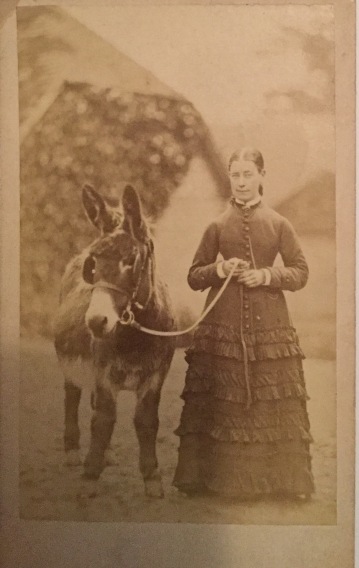
Sept 17th Friday. I went with Mr. & Mrs. Pamplin and his niece Miss F.H Williams to Dolgelly.
This is Thomas’ first mention of his future wife, Frances Harriet. It is unclear to what extent there was a degree of matchmaking on the part of her uncle William Pamplin. William himself had been widowed in 1876 when his first wife Caroline died from cancer. William married Margaret Parry, a local woman considerably younger than himself, two years later in 1878. One interesting point is that Frances’ mother, Frances Williams did not join the walk, although she was usually included in later walks. It is likely that she had accompanied her daughter to Wales, but the party consisting of Mr and Mrs Pamplin, Thomas and Frances encouraged an opportunity for conversation on a walk of some length.
We went with the first train to Bontnewyd. On our route we could see the effects of the great floods – the debris of bridges strewn in the bed of the rivers; riverside meadows covered with large stones, sand and gravel. There were plenty of signs of destruction all along the line from Llanwchllyn to Bontnewyd [SH771 201]. From Bontnewyd we went up past the village of Brithdir [SH767188] to the head of the Torrent Walk. The village is scattered about; the bulk of the houses being covered with creepers; the tropaeoleum speciosum being very conspicuous. There was an Independent Chapel in the village, and a school a little further on. From the village we had beautiful and extensive views. South of us stood Aran, on the north conspicuous were the cone of Moel Offrum and the high Rhobell-faur. West of us stood Cader Idris in all its beauty, its east side showing the steepness of it. The walk by the torrent was most pleasing; numerous cascades or steep slopes of rock, down which the water rushed; deep gorges when the water disappeared, overhung with lichen covered trees; the rocky slopes of the torrent being covered with moss, ferns or flowers. The little filmy fern (H. Wilsonii) being most beautiful and abundant.
We lunched by the torrent, and strolled down leisurely until we arrived at Dolserau gate. We next went through the grounds of Dolgûn [SH747184] which pleased my friends very much. I showed them the old smelting work, the beautiful trees of Dolgûn, and rare ferns, especially the Ceterach and a branching, fronded Asplenium trichomanes. We were all delighted with the walk, and as it was all new to my friends, they were full of admiration. On our way to Dolgelly we found the Tutsan St. John’s wort by the roadside. We crossed the river Aran which runs down from Cader, and got into Dolgelly by 3 pm. We had a substantial meat tea at the Talbot Hotel, where we were most comfortable.
After tea we walked out to Cymmer Abbey. On the way we passed the young ladies’ school, Dickson’s Nursery and the mansion of Hengwrt – once the residence of a noted antiquary Robert Vaughan. My friends stayed on the road in sight of the abbey while I went to see it. On my way down I saw fine walnut trees in the grounds. I entered the ruin which is a long nave with three windows (lancet) in the east end, the entrance being at the west end. The walls were built of shale except the coigns and mouldings. A great quantity of Asplenium trichomanes and the pellitory of the wall grew on the walls. The garden is a square attached to the abbey, but it has no very old trees. Along the south boundary wall there is a ditch full of water cress, showing that the monks cultivated it. The abbey is situated, as abbeys usually are, in a beautiful spot at the entrance to Llanelltyd valley, and close to the river Mawddach. We returned to Dolgelly at the back of Hengwrt, where we got charming views. While waiting until train time, we had a stroll about the town, which is famed for short, crooked streets, houses with entrances by outside steps, and everything in confusion. We returned home in good spirits and delighted with our very interesting and pleasant trip.
For both Frances Harriet and Thomas the walk was something of a test of their mutual suitability. Frances had been brought up in a town, but seems to have sustained two walks, the first about four and a half miles, partly over rough terrain, the second at least two and a half miles. This must have seemed satisfactory to Thomas, who was to lead her on many such demanding expeditions for the rest of her life. On her part, Frances appears to have relished Thomas’ commentary on all things botanical, geological and historic encountered along the way. This is not surprising as she was the grand daughter of a nurseryman and botanist, and the niece of a botanist and botanical bookseller. No wonder Thomas returned delighted and in good spirits from what was to be a very significant expedition.


 Sir Theodore Martin, via Wikipedia
Sir Theodore Martin, via Wikipedia